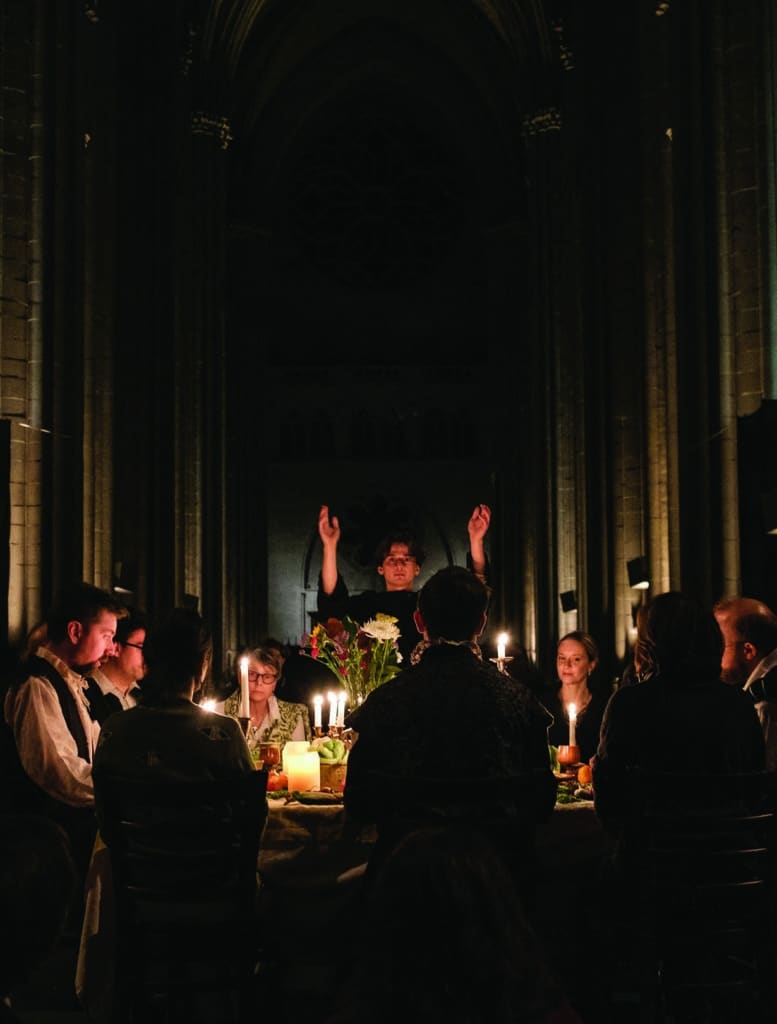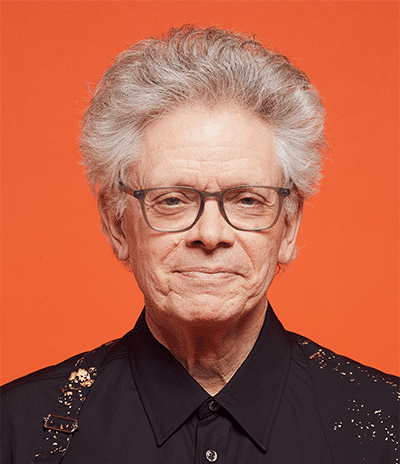Afraid of Nothing
The cellist Seth Parker Woods’ fearless embrace of the unknown.

Electroacoustic composer Pierre Alexandre Tremblay’s 2015 work asinglewordisnotenough 3 (invariant), for cello and electronics, begins with a central three-note motif of acerbic cello tones. Each bow stroke is synchronized with a burst of electronic static; the effect recalls the sound of a bouncing turntable needle. Separated by blocks of grainy sonic detritus, samples, and droning ambience, the cello gestures become increasingly pyrotechnic, bubbling up into frenzied, heavily manipulated peaks—as Tremblay puts it in his program notes for the work, “articulated transients / noises / textures / splices.”
In the majority of the performances of this singular work, the central figure has been Seth Parker Woods, the cellist for (or, as the composer prefers, with) whom Tremblay wrote the piece. At the time of its composition, in the mid 2010’s, Woods was a Ph.D. student at the University of Huddersfield in the UK, where Tremblay teaches. Tremblay first met Woods years earlier, while Woods was studying at Musik Academie der Stadt Basel. The young musician he encountered was an eager and versatile virtuoso from Houston just on the other side of his undergraduate study in New York City. He already boasted a formidable resume of collaborations alongside renowned orchestral, chamber music, and dance ensembles across Europe, as well as pop musicians from Lady Gaga to Adele to Lou Reed.
In those years, Woods was immersed in the European experimental music-theater scene, having participated in works by iconoclastic composers like Louis Andriessen, Aldo Tambellini, and Georg Freidrich Haas. Woods remembers a production of Haas’ provocative chamber opera Nacht as an exceptional moment during this period.
“[It had] nudity and Sprechstimme and all these different tunings and two different sets of cellos and moving from one part of the stage to another,” Woods explains, laughing. “I was like, ‘This is crazy.’”
“He was already comfortable with a very wide range of practices to start with,” Tremblay remembers. “He’d done about everything already. He was dancing with prosthetic things. He was afraid of nothing.”
By Tremblay’s account, the lines between student and professor quickly dissolved when he began to work with Woods on asinglewordisnotenough 3, as did those between composer and performer. The young cellist embraced strenuous techniques, such as the Bartok-famous snap pizzicato, which helps create the effect of, as Tremblay puts it, “a battle between left and right hand” in the piece. Challenging gestures like these resulted in bloody fingers for the next cellist to attempt the work. Tremblay, until then unaware of the true physical toll of the piece, was all the more moved by Woods’ stamina and commitment.
“He tells you it works and you write something based on that and you don’t know how involving it is,” Tremblay explains. “That’s the extent of his generosity. If it’s right for the piece, he’s going to do it and you don’t know. And that’s fantastic. I learned so much from him throughout that process.”
asinglewordisnotenough was featured on and provided the title for Woods’ 2016 debut LP, which helped establish the cellist as one of the most exciting rising figures on the international new music landscape. Today, the Tremblay piece remains one of Woods’ signature works: representative of his restless and adventurous spirit and penchant for taking on high-concept multi-disciplinary projects that push him to the very edge of his abilities as a live performer.
It’s also the only older work included in Woods’ evolving concert performance Difficult Grace, premiered during a residency with the Seattle Symphony in February 2020 and revised into a streamable film version during the pandemic. Incorporating speech, singing, dance, video, and more, the concert is a fluid cycle of commissioned and often collaboratively developed works. Woods drew inspiration (among so much else) from The Great Migration, works by Black visual artists including Jacob Lawrence and Barbara Earl Thomas, and the work of the Detroit poet Dudley Randall, whose 1964 poem “Primitives” provides the source of the work’s title and the libretto for one of its pieces. Moving outside of the traditional definition of the classical concert performer, Woods is credited as a “cellist, narrator/guide, and movement artist” in the notes for the show.
In revisiting asinglewordisnotenough in this context, Woods incorporated dancing by veteran choreographer Roderick George as a way of exploring “themes of the body and time,” in part through foregrounding George’s “aging dance body.”
“The beauty was still with him, building on years and years [of experience] and histories of dance and language that come from that,” Woods explained.
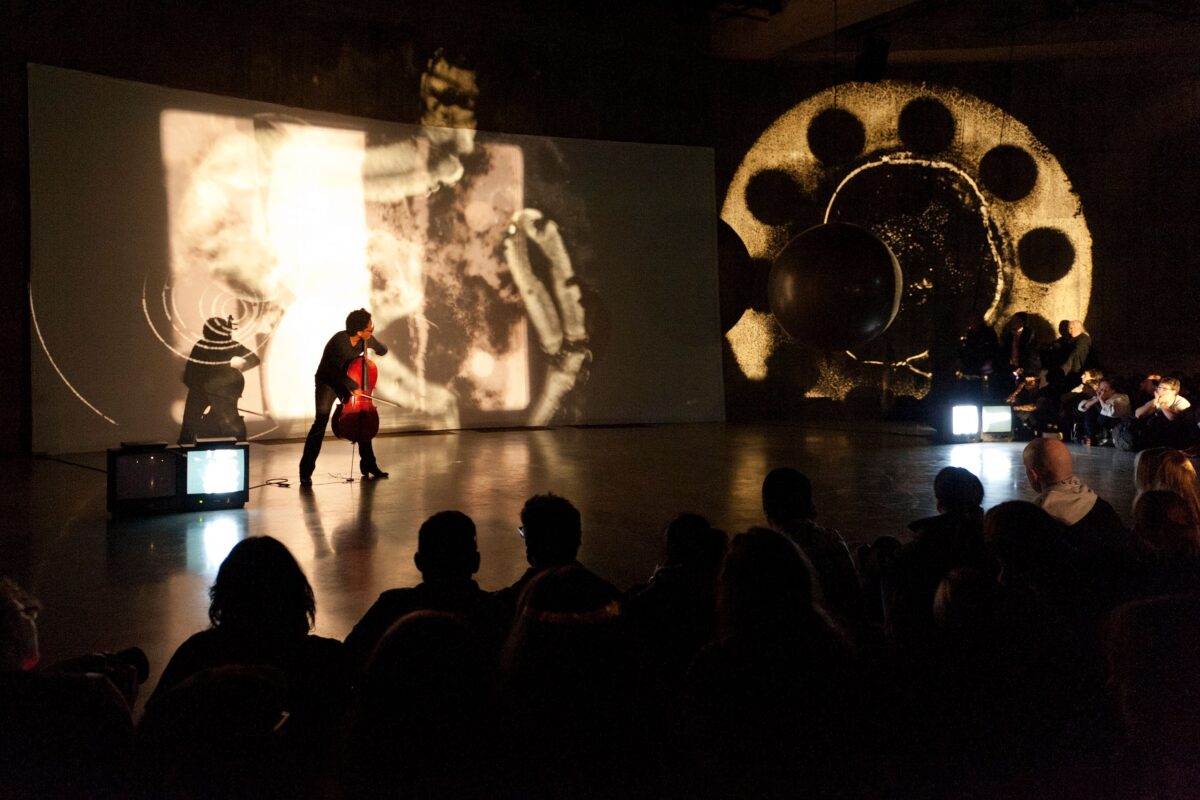
Woods’ interest in dance is a through-line in his career, cultivated during his tenure with the Berlin Staatsballett and his studies at Brooklyn College with New York Ballet principal cellist Frederick Zlotkin, and extending all the way back to the routines he choreographed to Motown tapes with his siblings in grade school. (“They called us ‘The Fake Jackson 5,” Woods tells me.) But Woods recalls participating in Basel Ballet’s Shut Up and Dance festival, which featured collaborations between up-and-coming choreographers and composers, as a watershed moment in his conception of the many exciting ways dance could be combined with music in inventive stage productions.
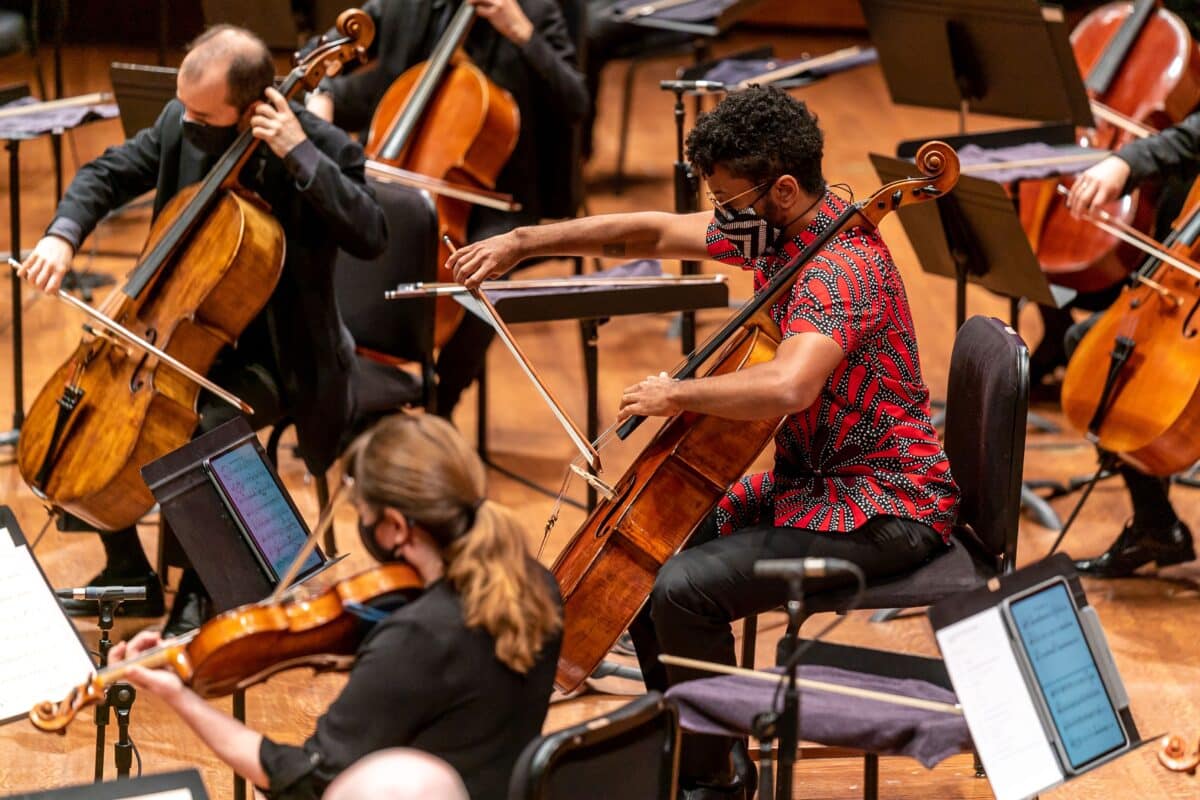
“Being in the rehearsals, making adjustments to the music, seeing the dancers react, thinking ‘Ooh I can use electronics in this way,’ looking at the staging and the costumes and the dramaturgy… I think I’d tapped into something I had been missing or that I didn’t know I needed—being a part of a big creative machine, building something on a bigger landscape that could touch a lot of people.”
In his studies at Huddersfield, he would channel these revelations into his Ph.D thesis project, titled Almost Human: The study of physical processes and the performance of a prosthetic spine. In the project, he created new works for cellist, dancer, and electronics that featured “prosthetic instruments” and employed, as he described it to Strings Magazine in 2017, “data and understanding from case studies related to the classical and contemporary music canon.”
“I started doing pieces that had speaking or acting cellists and trying to build these other factions,” Woods recalls. “I started to think ‘How could I bring this kind of work to life as this one-man show, where the cellist is the actor, the dramaturgist, the stenographer, and the storyteller?’”
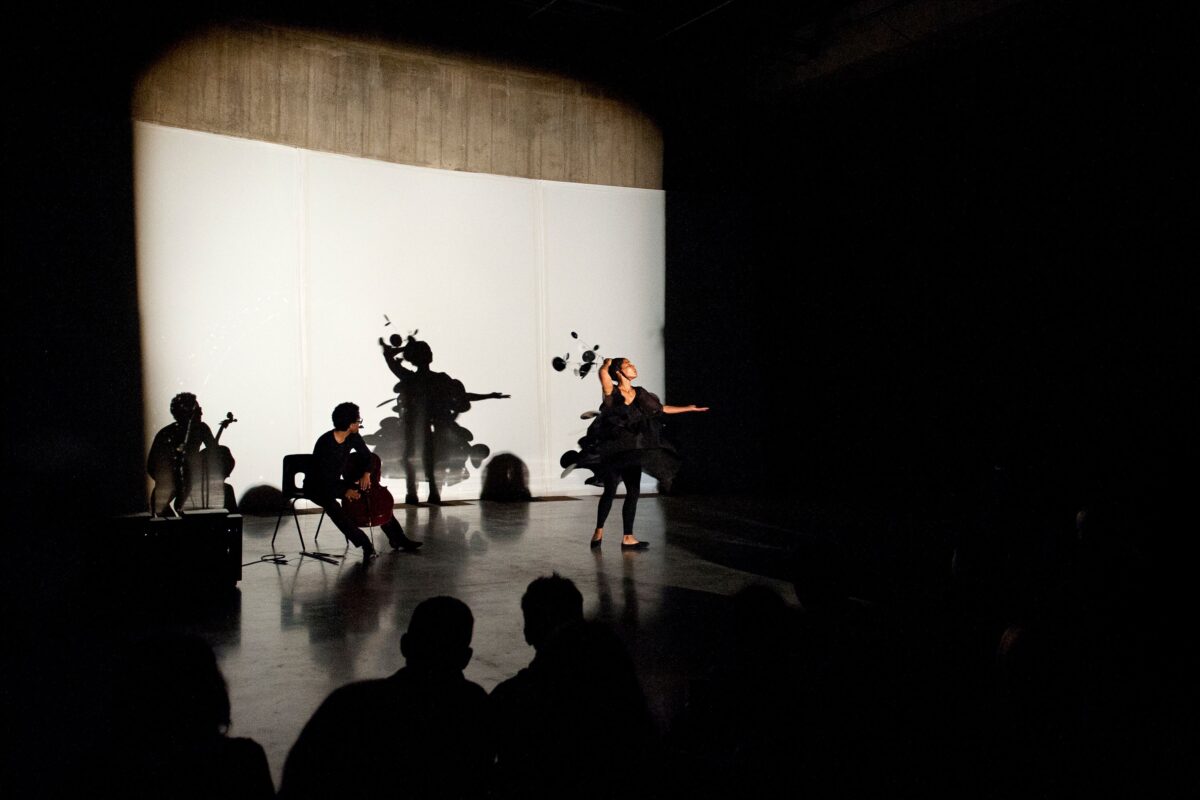
Back in America, while serving as a lecturer and artist-in-residence at the University of Chicago, Woods mounted his most brazen experiment in solo music-theater: a reimagining of ICED BODIES, the iconic 1972 work by the cellist and experimental performance artist Charlotte Moorman. In the piece, the cellist plays an instrument made of ice while it slowly melts. In Woods’ two-hour version, developed with sound designer and composer Spencer Topel, he wears a wetsuit, instead of performing nude as Moorman did. His custom-built obsidian ice cello emits ghostly electronic sounds and disembodied fragments of speech which are manipulated live by a sound designer. The piece culminates with Woods hacking at the instrument’s melting carcass and its mangled electronic innards.
Woods aimed to bring Moorman’s confrontational experiment into the 21st century by imbuing it with contemporary meaning. His version is an elegy for those affected by police violence and the manifold injustices of the American legal system, particularly people suffering from mental health conditions like schizophrenia.
“I wanted to think about what it meant to me to do this work in Chicago in 2016 and ‘17—about what was going on in Chicago and across the country,” Woods explains.
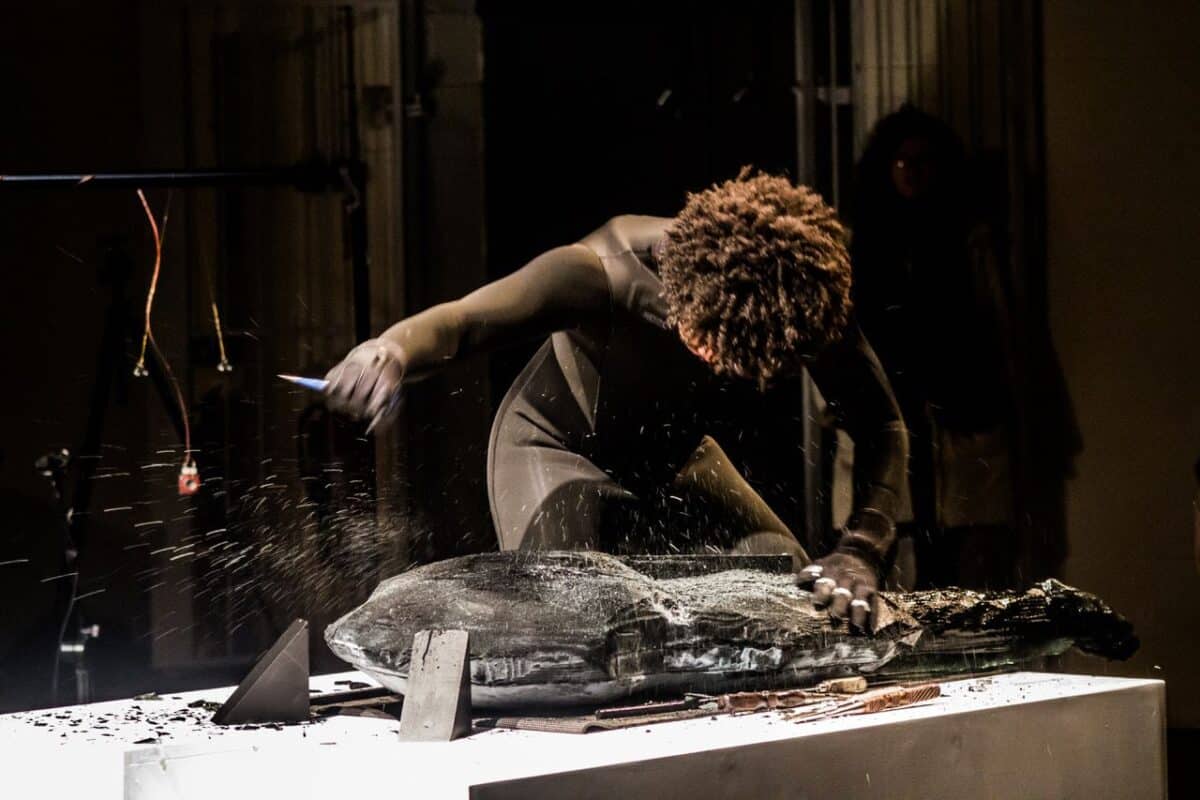
The Moorman project is emblematic of Woods’ wider interest in reanimating and drawing attention to the work of marginalized composers and performers. In recent years, he’s become a central figure in a flurry of activity around the works of Julius Eastman, the iconoclastic gay and Black minimalist composer active in the ‘70s and ‘80s; like Woods, Eastman’s work was informed by his background in dance and interest in electronic music, as well as improvisatory tendencies borrowed from jazz. Woods has also championed the works of George Lewis—the Association for the Advancement of Creative Musicians veteran, trombonist, and computer music pioneer—and premiered a major orchestral work by Tyshawn Sorey, one of the most respected names in the sphere of vanguard jazz and new music.
While working together on Sorey’s For Roscoe Mitchell in 2020, the two musicians bonded over their shared commitment to maintaining a maverick attitude toward musical creativity. “We can make any music that we want to make, despite what society tells us with regard to what we need to listen to or the art we must make given our cultural backgrounds,” Sorey explains. “We disregard such thinking in both of our creative practices. We’re kindred spirits, I should say.”
In the past several years, Woods has also positioned George Walker’s Cello Sonata as a central piece in his repertoire. Though Walker is celebrated for his Lyric for Strings and the Pulitzer-winning 1996 orchestral work Lilacs (he was the first Black composer to win the prize), much of the composer’s catalogue remains a relatively obscurity on American stages. Recently, Woods has incorporated the Sonata, written in 1957, into a new touring recital program with pianist Andrew Rosenbaum. The evening also includes a couple of Woods’ favorite common-practice works—Mendelssohn’s Cello Sonata No. 2 and Schumann’s Fantasy Pieces—and solo works by the early-20th-century Black composers Florence Price and Coleridge Taylor Perkinson.
When asked about his most meaningful experience working with Woods, it’s not a moment of collaborative playing that leaps out to Rosenblum, but rather the notes that Woods gave the pianist on his performance of Price’s Piano Sonata.
“Seth is an amazing coach and educator and that’s a big part of what he does,” Rosenblum explained. “He talked a lot about his experience with gospel music in the Black church and what the different events happening in the music might represent within that setting. He’s very committed not only to helping to gain representation for the music of Black composers but to helping people to find ways to express that music that are authentic to what its actual influences are.”
Though Woods is often associated with his multimedia Gesamtkunstwerk, his ongoing chamber music performances evidence his enduring engagement with more conventional musical presentations. In March and April, he will perform alongside Hilary Hahn and Andreas Haefliger on a program juxtaposing Beethoven and Kodály with a new commission. Woods is also preparing another solo album—his first since asinglewordisnotenough in 2016. He seems intent on remaining pliable as he explores how his artistic voice might come across most effectively in the LP format even as his work becomes increasingly audiovisual.
“I think in such an immersive way about curation—what that can mean for the creators in the space doing it or those that are observing,” Woods explains. “So I’m really thinking about that in the recorded medium for this next project, since there are so many pieces that involve me speaking or singing. It’s also very dramatic, so how do I capture that heightened level of performativity?”
The source material for the album comes from a reimagined version of Difficult Grace is due to premiere later this year, incorporating new works from Ted Hearne and Devonte Hynes (best known as the alternative R&B artist and producer Blood Orange). Though Woods put a great deal of effort into overhauling the initial draft of Grace for its film version earlier this year, it was a natural choice for him to reimagine the work yet again.
“You have to really look at the curation and the story [the work] is telling,” Woods explained. “Maybe they need to have rewrites. The premiere is never the end of the work—it’s really only the beginning.”
This is a broader theme for Woods, who seems to consider most of the projects he helms to be ongoing commitments. There is an eagerness to refine his interpretations and explore new tributaries within them. He is already organizing ideas for an album after the Difficult Grace project that will be more focused on chamber music, including—after years of evolution in the live setting—Walker’s Cello Sonata. This year, he’ll also build a new frigid instrument and introduce ICED BODIES into a post-pandemic world.
“What’s really fun and rewarding about collaborating with Seth is that there’s a really strong idea of what he wants to say from the beginning, but he really values the process of allowing the piece to become something very different from where it started,” Andrew Rosenblum reflects. “I think it’s all tied to an openness and desire to explore human expression in all its different forms.”
In Tremblay’s view, Woods’ hunger to explore and develop his signature works over time—shaping them, and letting them shape him—is evidence of his devotion to the betterment of the art, first and foremost.
“It’s a long view of artistic process, which is holistic,” Tremblay explains.

